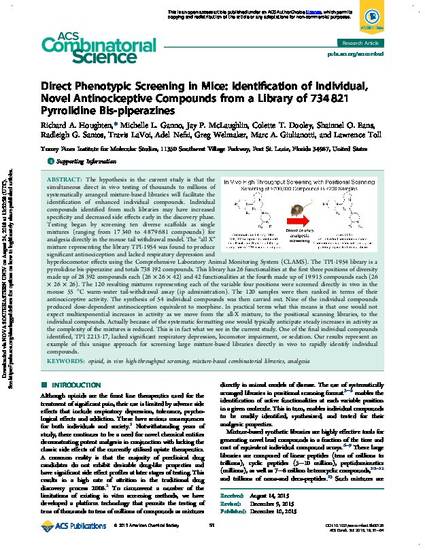
Article
Direct Phenotypic Screening in Mice: Identification of Individual, Novel Antinociceptive Compounds from a Library of 734 821 Pyrrolidine Bis-piperazines
ACS Combinatorial Science
Document Type
Article
Publication Date
12-10-2015
Keywords
- Opioid,
- in vivo high-throughput screening,
- Mixture-based combinatorial libraries,
- analgesia
Disciplines
Abstract
The hypothesis in the current study is that the simultaneous direct in vivo testing of thousands to millions of systematically arranged mixture-based libraries will facilitate the identification of enhanced individual compounds. Individual compounds identified from such libraries may have increased specificity and decreased side effects early in the discovery phase. Testing began by screening ten diverse scaffolds as single mixtures (ranging from 17 340 to 4 879 681 compounds) for analgesia directly in the mouse tail withdrawal model. The “all X” mixture representing the library TPI-1954 was found to produce significant antinociception and lacked respiratory depression and hyperlocomotor effects using the Comprehensive Laboratory Animal Monitoring System (CLAMS). The TPI-1954 library is a pyrrolidine bis-piperazine and totals 738 192 compounds. This library has 26 functionalities at the first three positions of diversity made up of 28 392 compounds each (26 × 26 × 42) and 42 functionalities at the fourth made up of 19 915 compounds each (26 × 26 × 26). The 120 resulting mixtures representing each of the variable four positions were screened directly in vivo in the mouse 55 °C warm-water tail-withdrawal assay (ip administration). The 120 samples were then ranked in terms of their antinociceptive activity. The synthesis of 54 individual compounds was then carried out. Nine of the individual compounds produced dose-dependent antinociception equivalent to morphine. In practical terms what this means is that one would not expect multiexponential increases in activity as we move from the all-X mixture, to the positional scanning libraries, to the individual compounds. Actually because of the systematic formatting one would typically anticipate steady increases in activity as the complexity of the mixtures is reduced. This is in fact what we see in the current study. One of the final individual compounds identified, TPI 2213-17, lacked significant respiratory depression, locomotor impairment, or sedation. Our results represent an example of this unique approach for screening large mixture-based libraries directly in vivo to rapidly identify individual compounds.
DOI
10.1021/acscombsci.5b00126
Citation Information
Richard A. Houghten, Michelle L. Ganno, Jay P. McLaughlin, Colette T. Dooley, et al.. "Direct Phenotypic Screening in Mice: Identification of Individual, Novel Antinociceptive Compounds from a Library of 734 821 Pyrrolidine Bis-piperazines" ACS Combinatorial Science Vol. 18 Iss. 1 (2015) p. 51 - 64 ISSN: 2156-8952 Available at: http://works.bepress.com/radleigh-santos/10/

Copyright © 2015 American Chemical Society
ACS Editors' Choice - This is an open access article published under an ACS AuthorChoice License, which permits copying and redistribution of the article or any adaptations for non-commercial purposes.